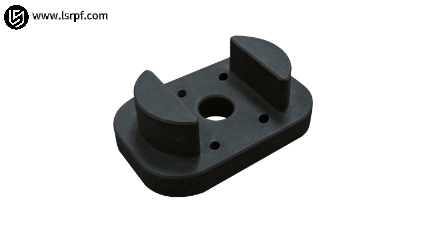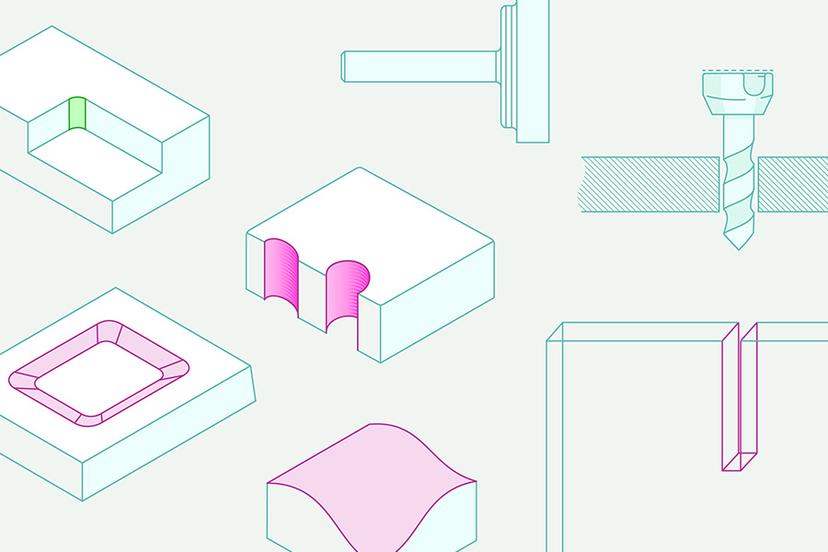CNC milling is considered one of the key technical means in the modern machining industry. Its design and engineering considerations are of significant importance in improving manufacturing efficiency, ensuring high quality of parts, and extending the working life of mechanical equipment. This study focuses on an in-depth analysis of the core design elements of CNC milling and factors that need to be considered in engineering. Its purpose is to provide valuable reference materials and operating guidelines for engineers and operators in the engineering field.
What is CNC Milling?
CNC milling is a process that usesCNC machine toolsand computer control systems that are independent of human operation to remove material by moving rotating cutting tools relative to the workpiece to produce custom-designed parts or products. The basic principle is that the processor formulates the processing technology, selects the processing parameters, and inputs the compiled processing program into the CNC device. The servo motor controls the relative movement of the tool and the workpiece according to a certain trajectory, thereby realizing the cutting of the workpiece and automatic processing.

How Does CNC Milling Work?
The CNC milling process is a highly preciseand automated manufacturing process commonly used to produce complex-shaped parts from a variety of materials such as metals, plastics, and wood. Below, the Longsheng team will introduce theCNC milling process step by step, including design product drawings, select the cutting tool,design the cutting path, set the machine tool parameters,install the workpiece, processing operation,processing inspection,and post-processing steps:
- Design product drawings:Based to the product requirements using computer-aideddesign software (such as CAD). The dimensions and positions of the holes and grooves to be milling are clearly marked on the drawings.
- Select the cutting tool:Select the appropriate milling cutter head according to the material and processing requirements of the product. For example, for thealuminum alloy material, the rigid carbide thread drilling and milling cutter can be selected.
- Design the cutting path:Determine the cutting path and processing sequence according to the product drawings. This helps to optimize the processing process and improve the processing efficiency.
- Set the machine tool parameters:Set the appropriate cutting speed, feed speed and cutting depth according to the material hardness and product requirements. For example, for aluminum alloy materials, themilling cutter speedcan be set to 2,000 r/min, the cutting speed is 314m / min, the milling feed is 0.06mm / tooth, etc.
- Install the workpiece:Attach the workpiece to be processed on the milling machine to ensure stability and positioning accuracy. This can be achieved by using fixtures or other tooling equipment.
- Processing operation:After the workpiece is stable and the machine parameters are set correctly, start the machine and start milling. In the processing process, it is necessary to closely monitor the cutting situation and timely adjust the cutting parameters to ensure the processing quality.
- Processing inspection:After milling, inspect the finish surface. This includes dimensional inspection, surface quality inspection, etc. to ensure that the processing quality meets the requirements.
- Post-processing:If a problem is found in the processing inspection, improve or grind accordingly until the requirements are met.

What Are the Key Design and Engineering Considerations in CNC Milling?
The key design and engineering considerations for CNC millinginvolve many aspects. The Longsheng team will lead you into the ocean of knowledge to consider in CNC milling engineering from five aspects: selection of milling tools, setting of cutting parameters, accuracy and stability of machine tools, workpiece clamping methods, and programming and operating skills:
- Selection of milling tools:Choosing appropriatemilling toolsis the key to ensuring processing efficiency and accuracy. Different types of cutting tools are suitable for different processing needs. For example, when processing larger planes, you should choose a face milling cutter; when processing the peripheral contours, grooves, and smaller step surfaces of flat parts, you should choose an end mill; when processing spatial curved surfaces, mold cavities, or punch forming surfaces, you should choose mold milling cutters. Knife etc. . In addition, factors such as the material, size and tool setting angle of the tool will also affect the processing effect.
- Setting of cutting parameters:When setting cutting parameters, the amount of cutting (such as rotation speed, feed amount, cutting depth, etc.) plays a key role in the quality and efficiency of processing. Therefore, various factors must be considered comprehensively when selecting cutting parameters. Appropriate cutting parameters help reduce tool wear, thereby improving processing accuracy and surface quality. All factors should be considered comprehensively when selecting cutting parameters. For example, using a smaller cutting depth and higher feed rate can improve production efficiency, but in order to prevent vibration and avoid tool damage, reasonable control must be carried out.
- Accuracy and stability of machine tools:For CNC milling machines, their accuracy and stability have a direct impact on the quality of processed parts. Because theCNC milling machine must have a high-precisionpositioning reference when working, it can have high positioning accuracy. The size and shape accuracy of the workpiece will be affected by many factors such as the accuracy of the machine tool coordinate axis, the accuracy of the bed guide rails, and the vibration frequency of the spindle. In addition, due to the structure of the machine tool itself, some failures are prone to occur during the processing, thus affecting the processing efficiency. Therefore, in order to ensure the accuracy of processing, it is crucial to select efficientCNC machine toolsand perform regular maintenance.
- Workpiece clamping method:The method of fixing the workpiece has a significant impact on the accuracy of its processing. In actual production, there are certain differences between different types of workpieces. In order to ensure product quality and improve production efficiency, the appropriate clamping method must be selected according to the specific product type. Improper fixation methods may deform the workpiece, thereby reducing the accuracy of the machining. In order to improve product production efficiency and ensure product quality, reasonable clamping methods must be selected according to different process requirements during mechanical processing. Especially when processing thin workpieces and workpieces with slender shafts, the accuracy and robustness of the clamping are particularly critical.
- Programming and operating skills:When programming, it should be noted that the dimensioning method on the part drawing should adapt to thecharacteristics of CNC machining. Use the same datum to quote the dimensions or directly give the coordinate dimensions to facilitate programming and dimension coordination. In addition, reasonable programming strategies and operating skills can reduce errors during processing and improve processing efficiency.

What are the types of CNC milling machines?
CNC milling machinescan be divided into many types according to their structure, function and processing capabilities. Focus on 3-axis CNC milling machines, 5-axis CNC milling machines and small CNC milling machines:
3-Axis CNC Milling Machines
A 3-axis CNC milling machine is a basic CNC milling equipment. Its main features include:
- Structure:The three-axis CNC milling machine uses three coordinate axes (X, Y, Z) for positioning and control. The X-axis is the transverse direction of the milling machine, the Y-axis is the longitudinal direction of the milling machine, and the Z-axis is the up-and-down direction of the milling machine.
- Processing scope:Three-axis CNC milling machine is suitable for processing simple geometric shapes, especially for the processing of flat and two-dimensional workpieces.
- Working principle:The computer program controls the precise movement of the tool in three directions to achieve milling of the workpiece.
- Advantages:The three-axis CNC milling machine has high processing accuracy and efficiency, and the operation is relatively simple and easy to master.
5-Axis CNC Milling Machines
5-axis CNC milling machineshave higher flexibility and processing capabilities than three-axis CNC milling machines. Its main features include:
- Structure:5-axis CNC milling machines usually include three linear axes (X, Y, Z) and two rotary axes (such as A, B, or C axes), which can work together to achieve more complex machining operations.
- Processing scope:5-axis CNC milling machine is suitable for processing complex geometric shapes, such as curved surfaces, variable bevels, etc. It can process multiple faces in one setup without changing fixtures or repositioning the workpiece.
- Working principle:The computer program controls the precise movement and rotation of the tool in five directions to achieve complex milling of the workpiece.
- Advantages:5-axis CNC milling machines have higher processing accuracy and efficiency, and can reduce positioning errors and processing time. At the same time, it can also process deep cavities with short tools, effectively improving system rigidity, reducing the number of tools, and reducing production costs.
Small CNC Milling Machines
The small CNC milling machine is a CNC milling equipment with compact structure and easy operation. Its main features include:
- Structure:Small CNC milling machines usually adopt a vertical structure, occupy a small area, and are suitable for use in places with limited space.
- Processing scope:Small CNC milling machines are suitable for processing small parts and complex-shaped parts. Through programming control, the tool can move simultaneously in multiple directions to complete the processing of complex-shaped parts.
- Working principle:The working principle of a small CNC milling machine is similar to that of a three-axis CNC milling machine. Both of them control the precise movement of the tool in a specified direction through a computer program.
- Advantages:Small CNC milling machines have a high degree of automation, which can reduce workers' labor intensity and improve production efficiency. At the same time, its compact structure and easy operation make small CNC milling machines more flexible when processing small parts and complex-shaped parts. In addition, small CNC milling machines are also widely used in the fields of education and scientific research, and can be used for classroom auxiliary teaching and teaching training of CNC technology.

What are the differences between 3-axis CNC milling and 5-axis CNC milling?
There are significant differences between 3-axis CNC milling and 5-axis CNC milling in terms of axial composition, processing range, processing efficiency, cutting accuracy, tool motion, scan line algorithm, application scenarios, cost and delivery time. These differences make the two suitable for different processing needs and fields.
| Projects | 3-axis CNC milling | 5-axis CNC milling |
| Axial composition | Three linear axes: X, Y, Z | Three linear axes X, Y, Z and two rotation axes A and B |
| Processing scope | Basic planar parts | Complex spatial surfaces such as curved surfaces, spheres, and deep cavities |
| Processing efficiency | Generally, multiple positioning is required | High, can reduce the number of repositionings when processing complex curved surfaces |
| Cutting accuracy | High, but random error is more likely | Higher, no need to reposition, reduce errors |
| Tool movement | Mainly moves in the X, Y and Z axis directions | While moving in the X, Y, and Z axes, the A and B axes rotate. |
| Application scenarios | General industrial parts processing | Aerospace, automotive parts, molds and other high-precision fields |
| Cost | Lower purchase and maintenance costs | Higher purchase and maintenance costs |
| Delivery time | long, carried out in stages, and needs to be repositioned | Short, continuous processing without stoppages and single-step processing |
What is the difference between CNC milling and CNC turning?
CNC milling is a subtractive manufacturing process that involves removing material from a solid block or sheet to create a shape or design, while CNC turning involves rotating a workpiece while a cutting tool removes material to create a cylindrical shape. CNC milling is better suited for producing parts with complex shapes and features, while CNC turning is better suited for producing parts with rotational symmetry.CNC milling machiningis more expensive initially due to higher setup costs, but can produce parts faster and in larger quantities, making it more cost-effective for large-scale production runs.CNC turning may be more cost-effective for smaller production runsdue to its lower setup costs.
CNC Milling
CNC milling is a subtractive manufacturing processthat involves removing material from a solid block or sheet to create a shape or design. The process uses a rotating cutting tool that moves along multiple axes to cut and shape the material. CNC milling machines come in various sizes, from small desktop machines to large industrial machines that can handle large-scale production.
Advantages of CNC Milling
- Can produce parts with complex shapes and features
- Suitable for a wide range of materials, including metals, plastics, and composites
- High accuracy and precision
- Fast and efficient production
- Can produce large parts and multiple parts simultaneously
Disadvantages of CNC Milling
- Higher initial setup costs
- Limited to producing parts with rotational symmetry
- Requires skilled operators to program and operate the machines
CNC Turning
CNC turning is a manufacturing process that involves rotating a workpiece while a cutting tool removes material to create a cylindrical shape. The process is commonly used to produce parts with a circular cross-section, such as shafts, bolts, and screws.CNC turning machine partscan be used for both small-scale and large-scale production.
Advantages of CNC Turning
- Suitable for producing parts with rotational symmetry
- High accuracy and precision
- Can produce parts with a smooth surface finish
- Fast and efficient production
- Suitable for a wide range of materials, including metals, plastics, and composites
Disadvantages of CNC Turning
- Limited to producing parts with a cylindrical shape or simple cross-sections
- Not suitable for producing parts with complex shapes and features
- Requires skilled operators to program and operate the machines
What Are the Applications of CNC Milling?
CNC milling is a precision machining methodthat uses CNC machine tools and computer control systems that are independent of manual operation to achieve high-precision machining of the shape and surface accuracy of workpieces.
1.Aerospace Industry
In the aerospace industry, CNC milling plays a vital role. Aerospace equipment is usually made of various hard metals and special materials. These materials, such as nickel-chromium high-temperature alloys, are difficult to process but require extremely high accuracy and reliability. CNC milling technology can effectively handle these difficult-to-machine materials and ensure that parts meet design requirements, thus improving the performance and safety of aerospace equipment.
2.Automotive Industry
With the rapid development of the automobile industry, efficient, high-precision, and high-stability processing of automobile parts have become the key to shortening product production cycles and improving corporate efficiency and competitiveness.CNC milling technology makes rapid prototypingand manufacturing of complex automotive parts possible, improving production efficiency and product quality. For example, precision CNC machining can maintain tolerances within ±0.0002 inches, ensuring precise fit between parts and reliable operation.
3.Medical Industry
In medical device manufacturing, CNC milling technology also plays an important role. Medical devices require retaining precise design features on a variety of metal and plastic substrates and quickly creating components and products. CNC milling technology enables these parts to be precisely manufactured to tight tolerances, ensuring high performance and reliability of medical devices. In addition, sinceCNC milling is suitable for one-off customized parts, it has broad application prospects in the medical industry.
4.Electronics lndustry
In the manufacturing of electronic products, the processing of housings is an important link. Traditional processing methods often require multiple processes, which are inefficient and difficult to control. CNC milling technology can complete the processing of the shell at one time by writing a processing program, which greatly improves the processing efficiency. At the same time, CNC milling technology can also realize the processing of complex shapes, such as arcs, concavities and convexes, etc., making the appearance of the shell more beautiful. In addition, CNC milling technology can also realize the processing of different types of shells through automatic replacement of tools, improving production flexibility.
5.Oil And Gas Industry
Another industry that requires tight tolerances is the oil and gas industry, which is critical to the safety ofCNC lathes. The industry utilizesCNC milling machines to create precision, reliable parts such as pistons, cylinders, rods, pins, and valves. These components are typically used in pipelines or refineries. They may require smaller quantities to meet specific quantities. The oil and gas industry often requires corrosion-resistant machinable metals such as aluminum 5052.
6.Marine Industry
The marine industry relies on high-quality craftsmanship as it creates water-based vehicles that may span the globe. Large-scale manufacturing processes for ships and other watercraft require automation to meet manufacturing deadlines and quality control. This is only possible through CNC milling. CNC mills, lathes, electrical discharge machining, and other processes can create nearly all marine components. These components include the hull and interior trim.
7.Military and Defense Industry
The needs of the military and defense industry are similar to those of the aerospace industry. These industries require not simple parts, but complex machinery for manufacturing a variety of innovative materials and precision equipment. The applications of CNC systems in these areas are vast, from the complex custom design of weapons airframes to the internal components of missiles.
8.Agriculture
Agriculture is a huge industry, producing everything from small shovels to large tractors and combine harvesters. CNC milling is used in every farm implement, regardless of size. There are many differentCNC machines used for cutting and drilling.
9. Mold Manufacturing
In mold manufacturing, CNC milling technology is an essential tool. Molds usually have complex shapes and high-precision requirements, and traditional processing methods are often difficult to meet the needs. CNC milling technology can realize the processing of complex molds through high-speed and high-precision cutting. For example, in the manufacturing ofplastic injection molds, CNC milling technology can accurately control the shape and size of the mold, improving the quality and production efficiency of plastic products.

Summary
Key design and engineering considerations for CNC milling involve milling machine equipment selection, tool selection, cutting parameter setting, and error control. Through scientific and reasonable selection and design, the advantages of CNC milling can be fully utilized to improve processing efficiency, ensure part quality and extend equipment life. In practical applications, appropriate processing plans and process parameters should be formulated based on specific processing needs and conditions and comprehensive consideration of various factors to achieve the best processing results.
Disclaimer
The content on this page is for reference only.Longshengdoes not make any express or implied representation or warranty as to the accuracy, completeness or validity of the information. No performance parameters, geometric tolerances, specific design features, material quality and type or workmanship should be inferred as to what a third party supplier or manufacturer will deliver through the Longsheng Network. It is the responsibility of the buyerseeking a quote for partsto determine the specific requirements for those parts.Pleasecontact usfor moreinformation.
LS Team
This article was written by multiple Longsheng contributors. Longsheng is a leading resource in the manufacturing sector, withCNC machining,sheet metal fabrication,3D printing,injection molding,metal stamping, and more.






